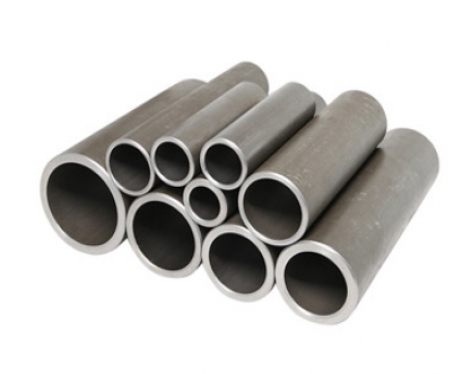The quality standards for checking 304 precision seamless steel pipes mainly involve the following aspects: material composition, mechanical properties, dimensional accuracy, surface quality, process control and testing methods. In order to ensure its safety, stability and durability in different fields, it must be uated strictly in accordance with relevant standards. Nansteel Manufacturing Co., Ltd carefully summarizes the following information on the quality standards of 304 precision seamless steel pipes:
1. Chemical composition (material composition)
The basic chemical composition requirements of 304 stainless steel should comply with international and domestic standards (such as ASTM, GB, JIS, etc.), and its core components include:
Carbon (C): ≤ 0.08%
Silicon (Si): ≤ 1.00%
Manganese (Mn): ≤ 2.00%
Phosphorus (P): ≤ 0.045%
Sulfur (S): ≤ 0.030%
Chromium (Cr): 18% ~ 20%
Nickel (Ni): 8% ~ 10.5%
These elements determine the corrosion resistance, high temperature resistance and plasticity of 304 stainless steel. The material composition of the steel pipe must be verified by spectral analysis or chemical analysis.

2. Mechanical properties
The mechanical properties of 304 precision seamless steel pipe are important indicators for uating its quality, including the following aspects:
Tensile Strength: ≥ 520 MPa
Yield Strength: ≥ 205 MPa
Elongation: ≥ 40%
Hardness: HRB 80 or less (depending on the specific application)
Mechanical properties testing can be carried out through tensile tests and hardness tests to ensure that the strength and toughness of the steel pipe meet the specified standards and are suitable for use in high temperature, high pressure or other harsh environments.
3. Dimensional accuracy
The dimensional accuracy requirements of 304 precision seamless steel pipes are relatively high, and common standards include:
Outer diameter tolerance: The tolerance range of the outer diameter is usually controlled within ±0.1mm ~ ±0.3mm.
Wall thickness tolerance: The wall thickness tolerance is usually controlled at ±0.2mm ~ ±0.4mm. The standard may vary depending on the pipe diameter and wall thickness.
Length tolerance: The general standard length is 6 meters, and the length tolerance is generally ±10mm. During the manufacturing process of precision seamless steel pipes, the dimensional deviation during cold drawing or hot rolling needs to be strictly controlled to ensure that the steel pipe meets the required precision requirements.
4. Surface quality
The surface quality of 304 precision seamless steel pipe needs to meet the standard of smoothness and no obvious defects. The uation criteria include:
Surface defects: no obvious surface defects such as cracks, pores, wrinkles, scratches, pits, etc.
Surface finish: The surface should be smooth and free of roughness, meeting the standard requirements, usually requiring Ra (surface roughness) ≤ 0.8μm.
Oxide scale: There should be little or no surface oxide scale. If there is oxide scale, it should be removed.
Surface quality can be tested by visual inspection, surface roughness measuring instruments, etc.
5. Consistency of inner and outer diameters and wall thickness
The inner and outer diameters and wall thickness of precision seamless steel pipes must be uniform to avoid local uneven thickness or deformation. Inspection methods include:
Outer diameter and inner diameter measurement: Use calipers, inner diameter micrometers or laser measuring instruments to accurately measure the outer diameter and inner diameter of the steel pipe.
Wall thickness detection: Ultrasonic thickness gauges or X-ray detection can be used to ensure the uniformity of wall thickness and avoid local weakness.
6. Nondestructive testing
For 304 precision seamless steel pipes, non-destructive testing (NDT) must be performed to ensure its quality:
Ultrasonic testing (UT): used to check whether there are cracks, pores, inclusions and other defects inside the steel pipe.
X-ray testing (RT): suitable for detecting structural defects inside the pipe.
Eddy current testing (ET): used to check the surface or near-surface defects of steel pipes.
Magnetic particle testing (MT) and penetrant testing (PT): usually used for the detection of surface cracks or local defects.
7. Annealing and hardness
304 stainless steel pipes usually need to be annealed to eliminate cold working stress and improve the plasticity and toughness of the steel pipe. After annealing, the steel pipe should maintain good hardness and ductility.
Hardness standard: Hardness is usually required to be HB ≤ 190, or other standards can be selected according to specific uses.
8. Welding and joint quality
For 304 stainless steel pipes that need to be welded, welding quality is critical. The strength, corrosion resistance and smoothness of the welded joint must meet the standards. Common welding quality standards include:
No cracks, pores, slag inclusions: Welded joints must be visually inspected and non-destructively tested to ensure that the welds are free of defects.
Welding method: Commonly used welding methods include TIG welding and MIG welding. The welding temperature and welding speed need to be guaranteed during the welding process.
9. Standards and certification
304 precision seamless steel pipes should comply with the following international or domestic standards:
ASTM A312: Standard for seamless stainless steel pipes with higher requirements.
GB/T 14975: Chinese national standard for seamless stainless steel pipes.
EN 10216-5: This standard is applicable to EU countries and specifies the production and technical requirements for seamless stainless steel tubes.
In addition, some industry applications may also require other certifications, such as ISO 9001 quality management system certification, ISO 14001 environmental management system certification, etc.
Read more: 304 Precision Seamless Steel Pipe Characteristics, Applications, and Processes
1. Chemical composition (material composition)
The basic chemical composition requirements of 304 stainless steel should comply with international and domestic standards (such as ASTM, GB, JIS, etc.), and its core components include:
Carbon (C): ≤ 0.08%
Silicon (Si): ≤ 1.00%
Manganese (Mn): ≤ 2.00%
Phosphorus (P): ≤ 0.045%
Sulfur (S): ≤ 0.030%
Chromium (Cr): 18% ~ 20%
Nickel (Ni): 8% ~ 10.5%
These elements determine the corrosion resistance, high temperature resistance and plasticity of 304 stainless steel. The material composition of the steel pipe must be verified by spectral analysis or chemical analysis.

2. Mechanical properties
The mechanical properties of 304 precision seamless steel pipe are important indicators for uating its quality, including the following aspects:
Tensile Strength: ≥ 520 MPa
Yield Strength: ≥ 205 MPa
Elongation: ≥ 40%
Hardness: HRB 80 or less (depending on the specific application)
Mechanical properties testing can be carried out through tensile tests and hardness tests to ensure that the strength and toughness of the steel pipe meet the specified standards and are suitable for use in high temperature, high pressure or other harsh environments.
3. Dimensional accuracy
The dimensional accuracy requirements of 304 precision seamless steel pipes are relatively high, and common standards include:
Outer diameter tolerance: The tolerance range of the outer diameter is usually controlled within ±0.1mm ~ ±0.3mm.
Wall thickness tolerance: The wall thickness tolerance is usually controlled at ±0.2mm ~ ±0.4mm. The standard may vary depending on the pipe diameter and wall thickness.
Length tolerance: The general standard length is 6 meters, and the length tolerance is generally ±10mm. During the manufacturing process of precision seamless steel pipes, the dimensional deviation during cold drawing or hot rolling needs to be strictly controlled to ensure that the steel pipe meets the required precision requirements.
4. Surface quality
The surface quality of 304 precision seamless steel pipe needs to meet the standard of smoothness and no obvious defects. The uation criteria include:
Surface defects: no obvious surface defects such as cracks, pores, wrinkles, scratches, pits, etc.
Surface finish: The surface should be smooth and free of roughness, meeting the standard requirements, usually requiring Ra (surface roughness) ≤ 0.8μm.
Oxide scale: There should be little or no surface oxide scale. If there is oxide scale, it should be removed.
Surface quality can be tested by visual inspection, surface roughness measuring instruments, etc.
5. Consistency of inner and outer diameters and wall thickness
The inner and outer diameters and wall thickness of precision seamless steel pipes must be uniform to avoid local uneven thickness or deformation. Inspection methods include:
Outer diameter and inner diameter measurement: Use calipers, inner diameter micrometers or laser measuring instruments to accurately measure the outer diameter and inner diameter of the steel pipe.
Wall thickness detection: Ultrasonic thickness gauges or X-ray detection can be used to ensure the uniformity of wall thickness and avoid local weakness.
6. Nondestructive testing
For 304 precision seamless steel pipes, non-destructive testing (NDT) must be performed to ensure its quality:
Ultrasonic testing (UT): used to check whether there are cracks, pores, inclusions and other defects inside the steel pipe.
X-ray testing (RT): suitable for detecting structural defects inside the pipe.
Eddy current testing (ET): used to check the surface or near-surface defects of steel pipes.
Magnetic particle testing (MT) and penetrant testing (PT): usually used for the detection of surface cracks or local defects.
7. Annealing and hardness
304 stainless steel pipes usually need to be annealed to eliminate cold working stress and improve the plasticity and toughness of the steel pipe. After annealing, the steel pipe should maintain good hardness and ductility.
Hardness standard: Hardness is usually required to be HB ≤ 190, or other standards can be selected according to specific uses.
8. Welding and joint quality
For 304 stainless steel pipes that need to be welded, welding quality is critical. The strength, corrosion resistance and smoothness of the welded joint must meet the standards. Common welding quality standards include:
No cracks, pores, slag inclusions: Welded joints must be visually inspected and non-destructively tested to ensure that the welds are free of defects.
Welding method: Commonly used welding methods include TIG welding and MIG welding. The welding temperature and welding speed need to be guaranteed during the welding process.
9. Standards and certification
304 precision seamless steel pipes should comply with the following international or domestic standards:
ASTM A312: Standard for seamless stainless steel pipes with higher requirements.
GB/T 14975: Chinese national standard for seamless stainless steel pipes.
EN 10216-5: This standard is applicable to EU countries and specifies the production and technical requirements for seamless stainless steel tubes.
In addition, some industry applications may also require other certifications, such as ISO 9001 quality management system certification, ISO 14001 environmental management system certification, etc.
Read more: 304 Precision Seamless Steel Pipe Characteristics, Applications, and Processes









